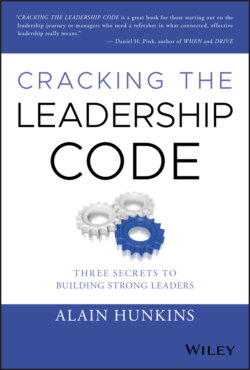Читать книгу Cracking the Leadership Code - Alain Hunkins - Страница 11
THE STORY BEHIND MY STORY
ОглавлениеMy entire life, I've been gripped by the question, “Why do people do what they do?” No matter how challenging or stressful the situation, I've always wanted to make sense of it. The need to make sense of stress goes way back for me. It started in my early childhood.
To preface this, my family loved me and fed me and housed me and did the best they could. However, I grew up in an apartment filled with screaming, stressful, dysfunctional leaders—that is, the adults. Even as a kid, I knew there had to be a better way. I could see the difference when I went to visit my friends. My friends' families would talk and listen to each other. They'd do stuff as a family together. Why couldn't my family be more like them? Why couldn't my mother and grandmother lead us more effectively?
Much of the time, my home life was like a toxic work environment. There was either yelling or a complete lack of communication. As a young child, I strived to please my mother and grandmother, thinking that if I did whatever they asked, then they'd be appeased and things would get better. As I got older, I realized that no matter how well I followed their instructions, my behavior didn't change their behavior. When I was the “good employee,” I still got the toxic treatment. Eventually, I checked out. I mentally and emotionally detached.
That primary stressful setting affected me greatly. I became highly attuned to other people's emotions and behaviors. I studied psychology and theater—disciplines that focus on human behavior and motivation. I learned about group dynamics and facilitation skills. And although I couldn't use all those skills to help my first “workplace,” I've been putting them to good use ever since.
What I've learned is that if you dig deep enough, there's always a story behind the dysfunction. If you can find a way to bring that story out of the shadow and into the light, there's the potential to change things. You can be freed up to lead with a story and not be stuck leading from the story.
In my case, I didn't really understand what was going on with my mother and grandmother until I was an adult. They'd hidden their stories from me when I was a child—maybe in an attempt to protect me. But their stories influenced our every interaction nonetheless.
I learned that my mother and grandmother were both Holocaust survivors. They had their lives torn apart by the horrors of war. Their crime? Being Jewish and living in Nazi-occupied Belgium during World War II.
My grandmother gave my mother away to the Belgian underground resistance to hide her as best they could. At the age of seven years old, my mother had her hair dyed blond and was given a false identity and address to memorize in case of capture. She was moved from orphanages to foster homes to convents to barns every few months. This went on for three years.
Meanwhile, my grandmother was hidden separately. But eventually she was discovered, arrested, and imprisoned in a Nazi concentration camp. She was one of the lucky ones; she was liberated at the end of the war. When my mother and grandmother were finally reunited in a Red Cross displaced persons camp, they pieced together the terrible truth: nearly all the rest of their family had perished.
You can imagine how living through such experiences would change your attitude and behaviors about the world. My grandmother lived the rest of her life vacillating between shell shock and rage. She could not move beyond her past. Yet she also served as the matriarch and head of our family—the person responsible for steering the rest of us and influencing our decisions.
I view my grandmother with compassion and can entirely understand why she behaved the way she did. However, no matter how much I loved her, there's no question that she was my first exposure to toxic leadership.
Ever since, in my personal and professional life, I've been driven to understand what actions:
Produce or destroy trust
Improve or stifle communication
Build bridges or walls
Create engagement or apathy
Create high performance or high dysfunction
Each person in an organization carries his or her own history. In working with clients and learning their stories, I've seen patterns emerge—specifically, patterns in behavior. I've seen how these behaviors are reinforced by leaders and solidify into a company's culture. This culture would then in turn influence interactions each employee would have with coworkers, colleagues, and customers. This translates into the experience of “what it's like to work here.” Although these forces are invisible, they impact on everything around them.
